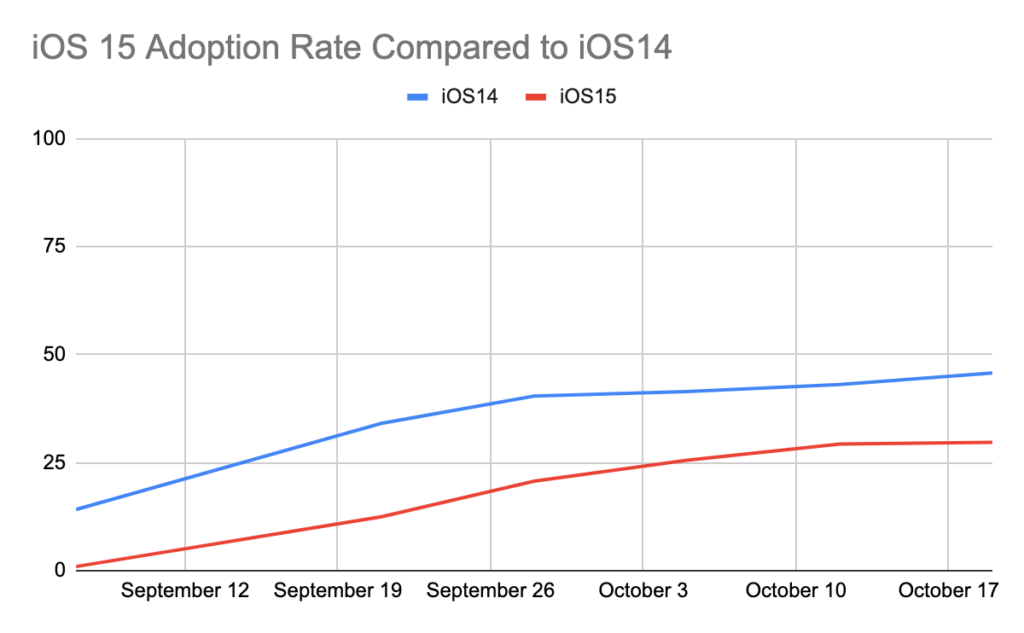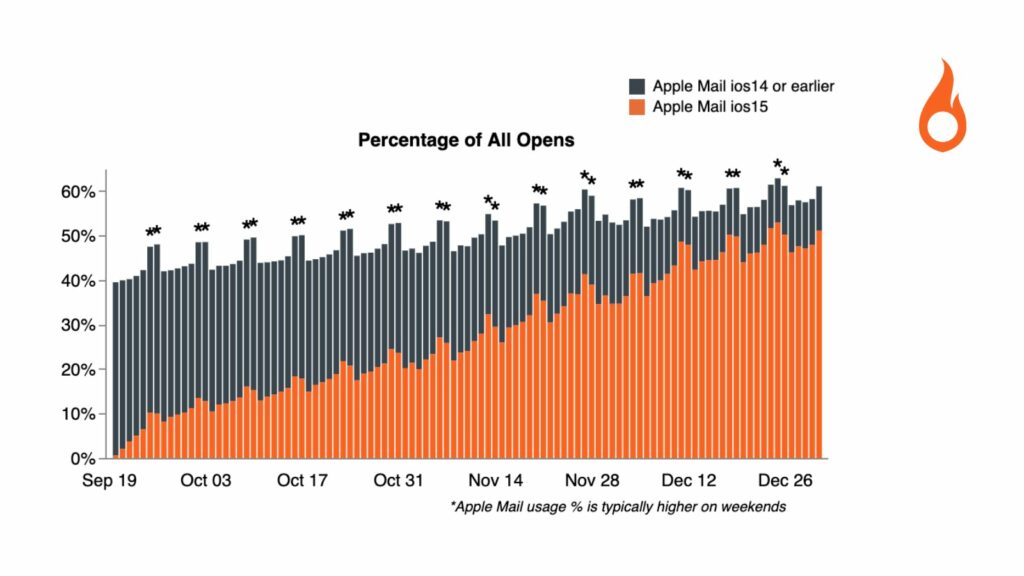iOS 15 launched on September 20 last year, and with it, the new Apple Mail Privacy Protection, promising to wreak havoc on email open rates. Did this new policy have any effect on email marketers? How should they act moving forward? We invited email experts from leading email marketing platforms to share their findings and provide in-depth answers to these questions.
Many blogs and articles covered the launch of Apple’s Mail Privacy Protection (MPP) before its launch on September 20. We were among that crowd and posted a comprehensive blog with predictions and actionable insights from 22 email marketing experts.
Now, five months later, iOS 15 users can opt in to hide their IP from email marketers. This means we can actively see how MPP affects email marketers in the real world.
We partnered with four of the top leading email marketing platforms in the industry to hear how they see the world of email marketing after the launch of iOS 15, exploring what they offer to email marketers on the day after.
Team email force, engage!
First: What is Apple’s Mail Privacy Protection?
Let’s start with the basics. If you’re familiar with them, skip ahead to the next part.
In June 2021, Apple announced the imminent release of iOS 15. The tech giant promised many features for Apple users, but one, in particular, caught the eye of every email marketer out there – Mail Privacy Protection.
This feature promised users using the Apple Mail App – be it on a Mac (macOS Monterey), an iPad, or an iPhone – that Apple will protect their privacy from the lurking eyes of email marketers.
Once users will opt-in, Apple said it will:
- Mask users’ IP addresses. And,
- Cache all images.
It may sound like mild changes for some, but email marketers were up in their arms. Some have been using IP addresses and images for years to personalize content and track subscribers’ engagement. Now, they were about to lose the ability to do the above as they won’t be able to track geolocation, use real-time images, and accurately rely on open rates.
While these ramifications hurt, the latter caused the most havoc when Apple announced this new policy. Some proclaimed it’s the end of email marketing as we know it, while some said this new initiative would finally force email marketers to focus on KPIs that matter.
Was all the fuss justified? Did Apple really change the email marketing game? Let’s find out what’s happening now.
Second: what the five top email marketing platforms have to say
To better understand how Apple MPP affects email marketers, we sat down with some of our partners. We all work with leading brands from across the world and handle the delivery of billions of emails every month.
Here’s how we all experienced the weeks and months after the launch of Apple MPP.
The @Ongage Marketing Team: The future of data-driven campaigns is click-driven.

#1 Let’s start with some data
First, we wanted to see if MPP is even a real thing. Are Apple users flocking to protect their privacy when prompted, or are they okay with things the way they are?
We took a look at all emails that are passing through our platform and saw the following.
When comparing the month before the iOS 15 rollout to the months after, Apple users’ average unique open rate rose by a staggering 100%.
It’s unlikely Apple users started opening more emails, and as such, we can conclude that MPP is indeed real. The rise in average open rates can be mainly attributed to Apple’s proxy servers delivering on their word and caching all images, including the open tracking pixel. The result is false opens and an increase in overall open rates.
We also see that the average open rates go up as the weeks and months go by.
This may mean that more and more iOS users are adopting iOS 15 and opting for MPP. Further, the recent launch of macOS 12 Monterey played a part in increasing the adoption rate, and email marketers must be ready.
#2 What do we currently do in Ongage to protect our customers?
Many email marketers rely on open data for their marketing efforts. They use it in their segmentation to target engaged leads – whether via inclusion or exclusion. On top of that, opens are being used in automation, either via transactional campaigns or automated drip campaigns.
As we saw, Apple users are opting for MPP. This means that by leaving your segmentation and automation as is, you may end up sending unintended emails to some of your subscribers.
To alleviate this issue, Ongage users can opt to ignore all Apple-related opens. Using this feature means the system won’t register any opens from Apple devices, real or fake, due to the inability to distinguish between the two.
If your userbase mainly consists of Apple users, you may find this approach a bit aggressive. Instead, consider altering segments and automations that are currently open-based to click-based. While this will shrink the number of emails you’ll send, you’ll win on two fronts:
- The emails you do send are based on a higher form of intent.
- You won’t send unintentional emails that are based on a fake open.
#3 What do we plan to do in Ongage to help our customers further?
On top of the above, the advice we gave in our previous experts’ blog still holds:
- Focus on metrics that signal real intent, starting with click rates, and going all the way to conversions. Then, use this data to better automate and personalize subscribers’ journeys and deliver intent-driven value rather than relying only on open rates.
- The best way to measure deliverability is still through ISPs. Sign up to Google Postmaster, Microsoft SNDS, and Verizon’s Postmaster Tools to accurately assess how your emails are performing. If you must, also look at soft bounces as a metric.
- Finally, remember that if someone opted in for Apple MPP, it means an actual human is behind the screen. This can help you with your email hygiene efforts by differentiating between spam traps and real subscribers.
Chris Adams @SparkPost – iOS 15 adoption is picking up

When Apple announced Mail Privacy Protection (MPP) at their Worldwide Developers Conference (WWDC21), it sent the email world into high alert. Marketers were rightly concerned that the tools and methods we have used for decades would be rendered ineffective, or worse, completely broken. No longer would marketers have visibility into the open behaviors of Apple’s native mail app users. What would this unprecedented change mean for email marketers trying to send relevant and engaging content to their subscribers?
We have been sifting the facts from the fears. The certainty from the confusion. And now that MPP is here, we want to share the trend our customers are experiencing as they adapt to this new reality.
Short-term: Minimal Impact. Long-term: Significant Impact.
Looking at our engagement data, we see that in the first few weeks since iOS15 launched, a relatively small percentage (20-21%) of all iOS opens came from iOS15 devices with a bit more activity on weekends.Additionally, Brian Sisolak has noted that users are upgrading to iOS15 at a slower rate than iOS14. Combine these facts, with the fact that MPP (currently) only pre-fetches when the phone is on wifi and charging, and – at first – senders didn’t see drastic changes in their overall open rates.

This data led us to predict that within the year, MPP will account for almost 40% of all opens.
It happened much earlier.
The chart below demonstrates that despite the slow start, Apple users are quickly flocking to iOS 15. In fact, as of today, the majority of opens coming from Apple’s Mail app are from the new OS.

This means you have to act. Some of the things we are recommending to our customers include:
- Make incremental improvements to how you track engagement.
- Use your click and conversion data to identify active users.
- Look at other omnichannel metrics, such as your website or mobile app usage.
- Revisit your calls-to-action to entice users to click and “get more info” in emails that they might have otherwise read, but not clicked.
Senders Need a Way to Reliably Identify Likely Pre-Fetched Opens
The other side of this MPP coin is that the other 40% of opens are not changing. However, to make effective use of the remaining data, senders need to be able to reliably identify which open events likely came from MPP (and any other future services which implement a similar mechanism).
At SparkPost, we have updated our Webhooks and Events API to allow customers to quickly and easily identify when an open has potentially been pre-fetched. This extra insight will give senders the information they need to make decisions about these types of open events.
We believe these changes by Apple are likely just the beginning. There will not be a better time than now to begin adapting to these changes. Looking holistically at how you track engagement with Apple MPP will undoubtedly prepare your sending for the next provider who inevitably adopts image prefetching. Chris Adams is VP and a Distinguished Engineer @SparkPost. He’s an avid cyclist and family man who also happens to be a passionate technologist and email analytics expert. He has more than 12 years of hands-on experience in the email industry, helping organizations make the most of their email campaigns.
Lauren Meyer @SocketLabs – The storm is coming, but it’s not here yet

Conversations about the fate of open rates dominated the second half of 2021 thanks to Apple’s MPP announcement in June. Debates over their relevance & accuracy, recommendations on other KPIs to use instead, conspiracy theories, and whispers about potential hacks to “save our beloved open rate”. Ok, maybe not so much on the conspiracy theories bit.
But quite frankly, the impacts of Apple’s MPP have not become an issue for our customers… not yet, anyway. We’ve noted changes in timing of opens associated with iOS devices (typically happening at night when users are charging their devices and connected to WiFi), which impact tactics like send time optimization. Otherwise, a lot less has changed than we expected. It’s pretty much business-as-usual.
The storm is coming, though. MPP adoption is growing, and other major providers (most notably Yahoo) have indicated their intention to follow this trend in consumer privacy. And they’ll likely implement their changes differently, adding to the uncertainty email marketers who rely upon open rates are feeling.
As a result, our efforts to date at SocketLabs have mainly been three-fold:
- Education, education, education. We’ve created blog posts, sent informational emails to customers, added notifications to the user interface, and updated our support team — who then updated our knowledge base — on how this change might affect customers. Education needs to be an ongoing effort as we continue to monitor the data.
- Continue to improve our email quality health score called StreamScore. It takes advantage of 1st party delivery and engagement data (such as delivery rates, opens, clicks, unsubscribes, and complaints) to gauge your sender reputation, in addition to a variety of 3rd party data points (including feedback directly from Google Postmaster Tools and SNDS, spam trap and blocklist intel, and more). The open rate is just one signal, and all testing confirms our StreamScore works just as well without it.
- Develop reporting tools that think like a Deliverability Expert. We’re on a mission to make email performance easier to understand so our customers can stop worrying about inbox placement (and open rates!), and spend time focusing on the rest of their to-do lists instead. In the coming months, we’ll roll out guided reporting tools that reduce hours spent scratching your head over email deliverability woes to just minutes. Stay tuned to our SocketLabs blog for more updates to come!
Lauren Meyer is a certified email deliverability geek @SocketLabs. She brings 15 years of experience in email with a heavy focus on deliverability, anti-abuse, and compliance. She is a vocal advocate for following industry best practices and having a proactive, data-driven approach to optimizing email performance and the larger customer experience.
Chad S. White @Oracle Marketing Consulting – Prepare for that inevitable reality

The rollout of Mail Privacy Protection started off much slower than many had expected, but the pace picked up considerably around the end of the year.
Even so, rather than worrying about the exact level of impact today, I recommend that marketers focus on recognizing that adoption of MPP will essentially be 100% by the end of 2022. Start working on tactical changes today to prepare for that inevitable reality.
On the technology side of the business, Oracle Responsys and Eloqua have made adjustments to around a dozen product features to adjust to Mail Privacy Protection. For example, we now identify Auto Opens that are generated by Apple and remove them from real opens so marketers can get a more accurate view of their opens. We have also changed our send time optimization and subject line optimization engines to focus more on optimizing clicks, which ensures the continued high performance of these tools.
On the consulting side, Oracle Marketing Consulting is helping our clients make the tactical adjustments that no platform can do for them. For example, any brand that has open-triggered journey series will need to change them in response to the fake opens generated by Apple. Opens just aren’t a reliable signal for these journeys anymore, so marketers will need to adopt one of a number of other approaches.
Probably the biggest challenge caused by MPP, especially for large senders, is how to select active audiences and manage their inactive subscribers. Individual-level opens have been critical to these activities, so marketers are going to have to build a broader view of subscriber engagement. We’ve already started doing this with some of our clients, and these new models include looking at a subscriber’s purchase activity, web sessions, app sessions, and other cross-channel activity, in addition to email clicks.
Perfecting these engagement models will take time and a fair amount of experimentation, as will making changes to journeys, re-engagement strategies, performance reporting, and other activities that are impacted by Mail Privacy Protection. Again, start working on all of these changes now so that you’re fully prepared as the impact of MPP grows over the next 12 months.
Chad is Head of Research @Oracle Marketing Consulting and is the author of “Email Marketing Rules.” With more than 3,000 articles and posts about email marketing, Chad was named the Email Experience Council’s 2018 Email Marketer Thought Leader of the Year.
Kate Nowrouzi @Pathwire – Did we overreact?

As of today, across all of our senders, we’re seeing roughly 80% of overall iOS opens coming from MPP. In general, we’ve not seen much effect on average open rates. In theory, this could be due to the number of automatic opens offsetting the total number of opens previously.
The impact is also different from one customer to another based on their business model and the type of traffic they send. The use of Apple products varies significantly across geographies and different demographics, so businesses will benefit from understanding what devices their subscribers use to read their emails.
A major social network on our side expected 50% of their user base to be impacted before the launch. In reality, 30 days post-launch, this impact is less than 15%.
For retail brands, we see a slow increase in the open rate, between 6-8%, over the past 30 days, which we believe to be due to pre-fetch activity. For a jobseeker network, we do not see any noticeable impact as most of their user base is Android users.
We are not seeing any impact on revenue across many customers we interviewed. This makes us believe the industry overreacted about this change.
Our current stance is primarily around educating customers that open rates have never been accurate, and it has been flawed for many years. Even before the iOS 15 changes, many edge devices and anti-spam scanners trigger automatic opens.
With that said, we do still believe that opens are still an indicator of engagement. If a message is delivered to the spam folder, it won’t generate an open event. The fact that you get an open event at all is indicative of an active user and this can still be used as a data point in the list hygiene.
In the near future, we also plan on releasing a flag that will help identify possible “automatic engagement,” allowing users to filter these events out. However, it’s still important to note that open rates will never be 100% accurate and are one piece of the puzzle to troubleshoot deliverability problems.
Kate is the Vice President of Email Deliverability & Product Strategy at Pathwire. With over 20 years of experience in messaging and online privacy space, Kate continues to be an active voice by speaking at conferences worldwide, hosting round tables, and publishing blog posts. She is the co-founder of #emailgeeksSF, a community where email marketers, designers, and developers meet to collaborate.


















